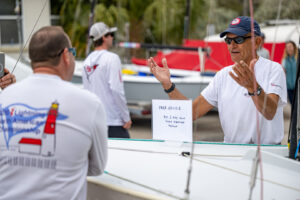
Ploch Tacking
The perfect tack is all in the preparation and the coordination of the crew. It’s relatively simple with dinghies, but when you get to keelboats, the more bodies you have moving across the boat, the more you need to syncronize everyone’s movement with the sail trim and turn.
One important part of the preparation is having marks on your jib tracks and your traveler, as well as on your sheets. These marks allow you to trim consistently with every tack. Another part of the preparation is having the cockpit in order before you start the tack: the weather winch has a handle in it (the leeward one does not), halyard tails are clear of working sheets and lead pullers, and the lazy sheet can run free. The jib car on the weather side should be pulled forward several inches to a marked setting; this keeps the top of the jib full and drawing as the jib is trimmed on the new tack.
When the housekeeping is taken care of, initiate the tack with a call from the helmsman. I use, “Tacking in 3 2 1 ” before turning the boat. The speed at which I want to tack is made clear by the cadence of my countdown.
At 3, the leeward or release jib trimmer looks to the working winch to make sure the jib sheet is clear, and that there’s no handle in the winch. No one is moving off the rail yet.
At 2, the release trimmer moves to the winch and eases the jib 2 or 3 inches. Easing it allows the top of the headsail to open slightly and make up for the trimmer’s weight off the rail. The rest of the crew slide inboard and make sure they’re not tangled in any loose sheets. The helmsman should be at or above target speed at the start of the tack.
At 1, the crew brings their torsos in and under the lifeline, staying on the rail, and here we go . . . “Tacking!”









